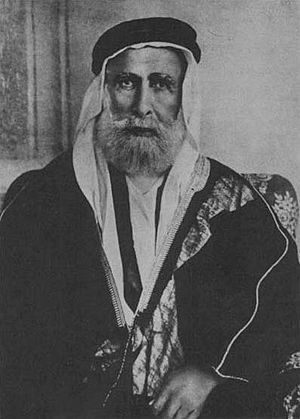Hussein bin Ali, Sharif of Mecca facts for kids
Quick facts for kids Hussein |
|
|---|---|

Sharif Hussein in 1916
|
|
| King of Hejaz | |
| Reign | 10 June 1916 – 3 October 1924 |
| Predecessor | Office established |
| Successor | Ali |
| King of the Arabs | |
| Reign | 10 June 1916 – 19 December 1925 |
| Predecessor | Office established |
| Successor | Office abolished |
| Sharif and Emir of Mecca | |
| Reign | 1 November 1908 – 3 October 1924 |
| Predecessor | Abd al-Ilah Pasha |
| Successor | Ali |
| Born | 1 May 1854 Istanbul, Ottoman Empire |
| Died | (aged 77) Amman, Transjordan |
| Burial | Al-Aqsa Mosque, Jerusalem, British Palestine |
| Spouse |
|
| Issue |
|
| House |
|
| Father | Ali Pasha bin Muhammad |
| Mother | Salha bint Gharam al-Shahar |
| Religion | Sunni Islam |
Hussein bin Ali Al-Hashimi (Arabic: الحسين بن علي الهاشمي, al-Ḥusayn bin ‘Alī al-Hāshimī; born May 1, 1854 – died June 4, 1931) was an important Arab leader. He came from the Banu Hashim family, which is a very old and respected clan. This family is directly related to the Islamic prophet Muhammad.
Hussein bin Ali was the Sharif and Emir of Mecca starting in 1908. A "Sharif" was a religious leader, and an "Emir" was a ruler. Mecca is a very holy city in Islam. Later, he led the Arab Revolt against the Ottoman Empire. This was a big fight for Arab independence. After the revolt, he became the King of the Hejaz from 1916 to 1924. For a short time, he also claimed to be the Caliph, which is a leader of all Muslims.
Contents
Early Life and Leadership
Hussein bin Ali was born in Istanbul, which was the capital of the Ottoman Empire. He was part of the Awn clan, a branch of the rulers of Mecca. Because he was seen as someone who might cause trouble, he was called to Constantinople (another name for Istanbul) in 1893. He stayed there and worked on the Council of State.
In 1908, after a big change in the Ottoman government called the Young Turk Revolution, Hussein was chosen to be the Emir of Mecca. This decision was made by the Sultan Abdul Hamid II.
The Great Arab Revolt
In 1916, a major event happened. Hussein bin Ali started the Arab Revolt against the Ottoman Empire. He did this with the promise of support from the British, who wanted to help Arabs gain independence. Hussein believed that the Ottoman government, led by a group called the Committee of Union and Progress, was not following Islamic rules and was taking too much power from the Sultan-Caliph.
Soon after the revolt began, Hussein declared himself 'King of the Arab Countries'. However, the Allies (countries like Britain and France) did not fully agree with his idea of ruling all Arab lands. They only recognized him as the King of the Hejaz, which was a region in what is now Saudi Arabia.
After World War I
After World War I, Hussein bin Ali faced new challenges. He refused to agree to the Treaty of Versailles. This treaty was signed after the war and decided the future of many lands. Hussein disagreed with it because of the Balfour Declaration. This declaration supported a Jewish homeland in Palestine. He also disliked that Britain and France were given control over areas like Syria, Iraq, and Palestine as "mandates" from the League of Nations.
Hussein also refused to sign a treaty with the British. This meant he lost their support when his kingdom was attacked by Ibn Saud, another powerful Arab leader.
Caliph and Abdication
In March 1924, the Ottoman Caliphate was abolished. This was a very important religious and political position. When it ended, Hussein proclaimed himself Caliph of all Muslims.
However, in October 1924, Hussein was losing the fight against Ibn Saud. Because of this, he stepped down from his role as king. His oldest son, Ali, became the new king. Hussein's other sons also became important rulers: Faisal became the king of Iraq, and Abdullah became the ruler of Transjordan in 1921.
Images for kids
-
Drawing by Khalil Gibran, 1916
See also
 In Spanish: Husayn ibn Ali (jerife de La Meca) para niños
In Spanish: Husayn ibn Ali (jerife de La Meca) para niños





